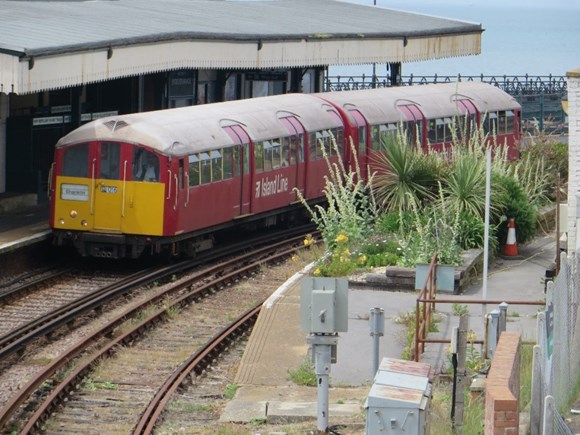
29 July 2020, 14:54
After more than 80 years of service – Island Line’s trains ready to retire

South Western Railway is looking for new homes for its soon to be retired Island Line fleet.
The 5 Class 483 trains, built in 1938 for the London Underground, have been serving the Isle of Wight since 1989. However, as announced in September 2019, following a £26m investment to secure the future of Island Line, the current fleet is due to be replaced by the Class 484 trains.
South Western Railway is looking for new homes for the trains as soon as possible, to make room for the arrival of the first Class 484s for testing this year. SWR has already received several expressions of interest from preservation groups, including the neighbouring Isle of Wight Steam Railway.
Organisations interested in adopting a soon to be former Island Line train will need to demonstrate the capacity and financial security to remove and look after the train, as well as a suitable long-term physical location for the train. They may also need to prepare a plan to manage potentially hazardous substances where these remain on the units, which will need to meet the satisfaction of the Office of Rail & Road and other statutory bodies.
The trains are also subject to a statutory Designation Notice following the decision of the Board of Trustees’ of the Science Museum on 4 March 2020. Prior to ownership transferring, SWR would need to ensure the future plans for some or all of the vehicles were acceptable to the Board of Trustees.
The trains are in varying states of repair, with two of them having been used largely for spares in recent years.
Mark Hopwood, Managing Director for South Western Railway said: “The Class 483 trains have been running for 82 years, serving passengers first on London Underground and most recently on the Isle of Wight. Despite their age our team at Ryde St John Depot has worked miracles keeping these trains going to provide a vital service for the island.
“With new trains arriving, now is the time for these trains to find new homes, for a well-deserved retirement.”.
Organisations interested in rehoming a former Island Line train should express their interest by emailing 484Project@swrailway.com. The deadline for expressing interest is Wednesday 12 August.
Contact Information
South Western Railway Press Office
press@swrailway.com
Notes to editors
Originally built in 1938, these trains operated London Underground’s Northern Line until they were withdrawn from service in the late 1980s.
In July 1989, the first of the 1938 stock, now the Class 483, arrived on the Isle of Wight to operate the 8.5-mile Island Line, from Ryde Pier Head to Shanklin.
The trains have now seen over 80 years of passenger service, 30 of which have been on Island Line
In September 2019, South Western Railway announced £26m of investment in Island Line that would see the Class 483 replaced by VivaRail’s Class 484 trains, as well as improvements in infrastructure allowing for a trains service at regular 30 minute intervals.
In keeping with Island Line’s tradition of former London Underground trains, the new trains will be refurbished former District Line trains, but with modern features including WiFi, passenger information screens and dedicated wheelchair spaces.
South Western Railway
Operating over 1,500 services each weekday, SWR provides commuter, regional and long distance services to customers in South West London, the southern counties of England and the Isle of Wight.
As well as commuters and business travellers, SWR transports leisure travellers across the region, to many tourist and heritage sites, and the numerous major sporting and social events that take place along the route every year.
SWR provides easy and convenient mobility, improving quality of life by connecting people and communities.
About DFTO
DFTO is the government’s public sector rail owning group. Its purpose is to bring all currently privately-owned train operators into public ownership in advance of the creation of Great British Railways in 2027. Alongside Network Rail, it is one of the ‘twin engines’ of GBR and is enabling and driving forward crucial rail reform.
The group’s current train operating companies are: LNER, Northern, Southeastern, TransPennine Express, SWR, c2c and Greater Anglia. This means that half of the train operators (7 out of 14 train operating companies) that will form the backbone of passenger services under Great British Railways (GBR) are now in public ownership.
Together, the DFTO group employs more than 26,000 people; runs almost 8,000 daily services and manages more than 1,000 stations.
It delivers more than 550 million customer journeys across its networks every year, accounting for 33% of all UK passenger journeys.

